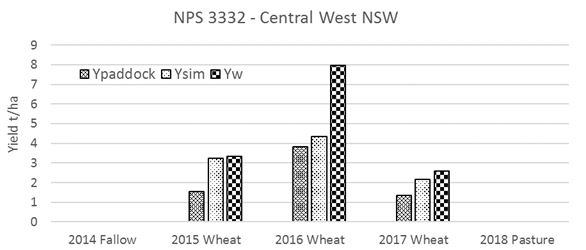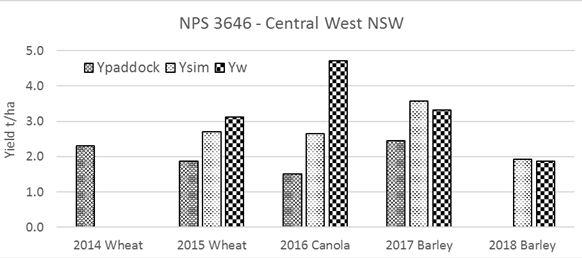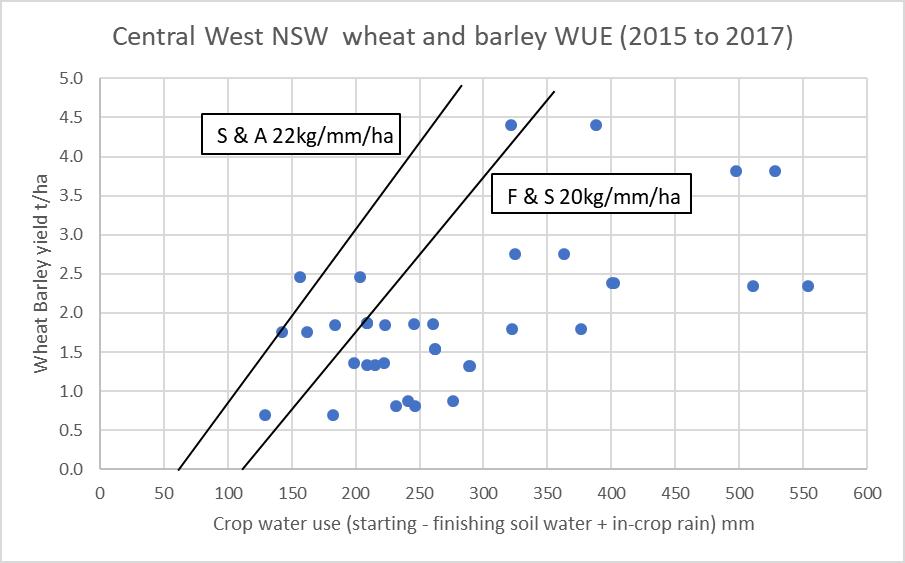National paddock survey – closing the yield gap and informing decisions
Take home messages
(from work undertaken on 10 paddocks in Central West NSW, 2015 to 2018)
- Intensive monitoring of soils and crops over a rotation sequence has identified why crops do not achieve their potential yield
- Reviewing paddock performance at the end of the season and using paddock records is essential for sustained improvement in agronomic performance. The average yield gap of wheat and barley over four years of monitoring in the NSW Central West region was 30%
- Over the four-year rotation 20 paddock zones were intensively monitored (over the duration of the project: 80 paddock zone records). Of these, 60 paddock zones were planted to a cereal and 6 to canola. 2016 was a wet year, 2015 had average rainfall and 2017 and 2018 were dry. Insufficient nitrogen was the main cause for the yield gap - especially in 2016. No N deficiencies were recorded in 2018. Diseases, weeds and insects also contributed, but were less severe in impact. Frost and heat shock were also a significant cause of the yield gap - especially in 2017 and 2018.
Background
Yield gap is the term applied to the difference between achieved and potential yield, where potential yield is estimated from simulation models. On average, Australia’s wheat growers are currently estimated to be achieving about half their water-limited potential yield (Hochman et al. 2016, Hochman and Horan, 2018). Previous research with individual growers in the Wimmera/Mallee in Victoria determined that the long-term yield gap for those farmers was approximately 20% (van Rees et al. 2014). A national overview of the estimated yield gaps can be viewed at Yield Gap Australia's website.
The National Paddock Survey (NPS) is a four-year (2015 to 2018), GRDC-funded project designed to quantify the yield gap on 250 paddocks nationally and to determine the underlying causes. Further, its aim is to establish whether management practices can be developed to reduce the yield gap to benefit farm profitability. The project aims to provide growers and their advisers with information and the tools required to close the yield gap.
Method
Nationally 250 paddocks, 80 in each of WA and N NSW/Qld, and 90 in S NSW, Vic and SA, were monitored intensively over a four-year rotation (2015 to 2018). Consultants and farming systems groups undertook the monitoring. Two zones in each paddock were monitored at five geo-referenced monitoring points along a permanent 200 to 250m transect. Each monitoring point was visited four times per season (pre and post-season soil sampling and in-crop at the equivalent crop growth stages of GS30 and GS65). Yield map data was obtained for each paddock which enabled the yield of each zone to be determined accurately. Table 1 lists the annual monitoring undertaken in each zone.
All paddocks were simulated with APSIM (Holzworth et al. 2014) and during the season, Yield Prophet was available to all consultants and farmers.
The whole data set (four years x 500 paddock zones) is being analysed by Roger Lawes, CSIRO for factors primarily responsible for the yield gap in each of the three GRDC regions (Lawes et al. 2018).
This paper outlines the results of ten paddocks monitored by Helen McMillan from Central West Farming Systems (CWFS). The results are discussed as a paddock specific yield gap analysis over four seasons focused on outcomes for the farmer and the farm group.
Results are presented as the modelled APSIM simulations in which:
- Ya = actual yield (as determined for each zone from yield map data)
- Ysim = simulated yield (for the same conditions as those in which the crop was grown)
- Yw = simulated water limited, nitrogen unlimited yield (for the same conditions as those in which the crop was grown, but with N supply unlimited). Yw is considered the potential yield for the crop.
Note: APSIM currently accurately simulates wheat, barley and canola. We have not attempted to simulate the other crop types grown (lupins, lentils, fababeans, chickpeas, vetch, field peas).
The yield gap is calculated as the % difference between Yw and Ya using the equation ((Yw-Ya)/Yw).
Table 1. Overview of monitoring and data collected per zone for each NPS paddock
Monitoring | Timing | Monitoring | Timing |
|---|---|---|---|
Deep soil test 4 depths (0-100cm) | Pre-sow | Paddock yield and yield map data | Post-harvest |
PREDICTA®B (0-10cm) | Pre-sow | Crop density, weeds, foliar diseases, insects (/m2) | GS30 |
Deep soil test 4 depths (0-100cm) | Post-harvest | Cereal root sample to CSIRO | GS30 |
Crop and cultivar | Weeds, foliar diseases, insects /m2) | GS65 | |
Sowing date and rate | Cereal stubble/crown for Fusarium | Post-harvest | |
Fertiliser, herbicide type, rate, date | General observations | ||
Temperature buttons (1 per paddock) | GS60-79 |
Data was entered via the NPS website and stored in a purpose-built SQL server database.
Results and discussion
Annual individual paddock results
Data from two paddocks in Central West NSW are presented as examples of outputs as informed by the paddock monitoring.
Example 1. Paddock Central West NSW, NPS 3324. Rotation: Fallow (2014), followed by wheat, wheat, wheat, pasture.
Zone A: sandy loam over light clay (red duplex)
Figure 1. Example 1 - rotation Central West NSW: fallow (2014), followed by wheat, wheat, wheat, pasture (Ya=actual yield; Ysim=simulated yield; Yw=water limited N unlimited yield (potential yield))
Paddock and crop information over the rotation (Note - nd is ‘not detected or not determined’)
Available nitrogen (pre-sowing)
- 2015 (following fallow): 161 kg/ha
- 2016 (following wheat): 122 kg/ha
- 2017 (following wheat): nd
Available water (pre-sowing)
- 2015: 97 mm
- 2016: 157 mm
- 2017: nd
Disease
PREDICTA B:
- 2015 Phoma & Pythium moderate
- 2016 Yellow leaf spot (YLS) & Pythium moderate
- 2017 Yellow leaf spot (YLS) high, Pythium moderate
Cereal root health GS30:
- 2015 root health score: low level disease, Pythium moderate
- 2016 root health score: moderate level disease, Fusarium high
- 2017 root health score: low level disease
Cereal stubble - Fusarium:
- 2015 not detected
- 2016 & 2017 very low
In-crop GS65:
- 2016 YLS
Weeds (in-crop GS65)
- 2015 black oats 1 /m2
- 2016 black oats 2 /m2, dense stonecrop 37 /m2
- 2017 Charlock 1 /m2
Insects
- 2015 Aphids low level
Heat and frost
Table 2. Days of heat and frost during GS60-79
Heat > 34 oC | Frost 0 to -2 oC | -2 to -4 oC | |
|---|---|---|---|
2015 | 0 | 0 | 0 |
2016 | 0 | 0 | 0 |
2017 | 1 | 0 | 0 |
(note: temperature records from nearest Bureau of Meteorology site)
Consultant notes
- 2015: GS65 crop drought stressed
- 2016: GS65 black oats common
- 2017: paddock under-sown with lucerne and medic (low seeding rate)
Interpretation
- Crop 2014: Fallow
- Wheat 2015: Ya<Ysim=Yw crop not N stressed, observations at flowering indicated drought stress
- Wheat 2016: Ya=Ysim<Yw. N unlimited yield (Yw) was 3.5t/ha higher than the simulated yield (Ysim), indicating the crop was N deficient. Ya=Ysim indicates other factors had little impact on yield
- Wheat 2017: Low yield, dry season. Paddock under-sown with lucerne and medic.
Example 2. Paddock Central West NSW. NPS 3646. Rotation: Wheat (2014), followed by wheat, canola, barley, barley
Zone A: sandy loam over light clay (red duplex)
Figure 2. Example 2 - Rotation Central West NSW: wheat (2014), followed by wheat, canola, barley, barley (Ya=actual yield; Ysim=simulated yield; Yw=water limited N unlimited yield (potential yield))
Paddock and crop information over the rotation (Note - nd is ‘not detected’ or ‘not determined’)
Available nitrogen (soil N pre-sowing)
- 2015 (following wheat): 89 kg/ha
- 2016 (following wheat): 113 kg/ha
- 2017 (following canola): 115 kg/ha
- 2018 (following barley): 131 kg/ha
Available water (soil water pre-sowing)
- 2015: 57 mm
- 2016: 91 mm
- 2017: 125 mm
- 2018: 81 mm
Disease
PREDICTA B:
- 2015 - nd
- 2016 - YLS high, Pratylenchus thornei moderate
- 2017 – nd
- 2018 - nd
Cereal root health GS30:
- 2015 – root health score: moderate level disease; Fusarium moderate
- 2017 – root health score: low level disease
Cereal stubble - Fusarium:
- 2015 – nd
- 2017 - low (Fusarium 5% stems)
Disease in-crop GS65:
- 2015 - YLS moderate
- 2018 – Spot form net blotch (SFNB) moderate
Weeds (In-crop GS65)
- 2015 - Sow thistle 1/m2
- 2016 - Bindweed 1/m2
Insects
- Aphids low level in 2015, 2017
Heat and frost
Table 3. Days of heat and frost during GS60-79
Heat > 34 oC | Frost 0 to -2 oC | -2 to -4 oC | |
|---|---|---|---|
2015 | 3 | 1 | 0 |
2016 | 0 | 1 | 0 |
2017 | 0 | 5 | 1 |
2018 | 0 | 5 | 0 |
(note: temperature records from nearest Bureau of Meteorology site)
Consultant observations
- 2015: GS65 YLS common
- 2016: early growth was poor (no rain), crop recovered in August
- 2017: GS65 lot of aphids
- 2018: paddock yield not available at time of writing
Interpretation
- Wheat 2014:
- Wheat 2015: Ya<Ysim=Yw. Crop limited by abiotic and biotic stress. Heat shock and 1 frost during flowering.
- Canola 2016: Ya<Ysim<Yw. N was limiting (Ysim<Yw). One frost during flowering and podding.
- Barley 2017: Ya<Ysim=Yw. Low level of Fusarium and repeated frosts could have contributed to the yield loss observed.
Assessing crop performance: Water Use Efficiency vs modelling
The first paper on Water Use Efficiency (WUE) was published by French and Schultz in 1984. It was a break through at the time, enabling farmers and agronomists to benchmark crop performance against a target and compare performance against other wheat crops. The French and Schultz WUE equation has since been updated by Sadras and Angus, 2006 and Hunt and Kirkegaard, 2012.
Hunt and Kirkegaard, 2012 calculate crop water use as: soil water pre-sowing – soil water post- harvest + rainfall during the same period. WUE is then calculated as yield (kg/ha) / (crop water use - 60). Potential yield is calculated as 22 x (crop water use – 60).
The 2015 to 2017 Central West NSW NPS cereal yields are plotted against crop water use in Figure 3. The graph reveals a general tendency for Ya to increase with crop water use with an upper boundary of yield. The upper boundary is reasonably interpreted as Yw for well-managed crops as crop water use increases. The two lines included on the diagram are the Yw lines proposed by French & Schultz, 1984 and Sadras & Angus, 2006 to describe the most efficient use of water. This establishes a common maximum WUE of 22 kg/mm/ha.
Figure 3. NPS – Central West NSW cereal paddock yield plotted against water use (2015 to 2017).
How useful is WUE compared with computer modelled assessments of potential yield, and what will the future hold?
Figure 3 and other data analysed by French & Schultz (1984) and Sadras & Angus (2016) demonstrate a considerable variation in Ya relative to Yw, i.e. a considerable yield gap in many crops. Key questions for farmers and agronomists are: what is the cause of the yield gap in each individual case and how can it be alleviated?
There are many possible causes that cannot be identified without careful paddock monitoring of abiotic and biotic factors, as attempted in the present project.
We must remember that using WUE to assess yield potential is a bucket approach to a complex system with many interactions. WUE will not explain the causes of a yield gap, nor can it inform on reasons for favourable outcomes. It may identify the presence of a yield gap but not their underlying cause(s).
Causes of yield gaps
Abiotic factors
Variability is a feature of farming in Australia and there are several reasons why crop roots cannot access soil water and nutrition such as soil type (texture) and physical and chemical limitations. Chemical and physical constraints to root development can have a large impact on potential yield such as high soil chloride levels in some regions. Frost and heat shock are two other abiotic factors which can have a large impact on crop yield.
Interactions between soil type, available soil water and the amount of water extracted by the growing crop are influenced by crop growth and the distribution and amount of rainfall. If these factors are ignored there is limited predictive capability of yield.
High and low temperatures at critical times of crop development can further cause devastating yield loss.
Crop nutrition appropriate to achieving potential yield (Yw) is relatively well understood and for N, there are many examples of successful tactical responses to fertilisation. But this is not matched for other nutrients such as P, K and micronutrients such as Zn.
Biotic factors
Major infestations of weeds, pests and diseases can cause yield loss and less serious infestations may cause greater losses than is commonly appreciated. The extent of these losses remains unknown without careful paddock monitoring.
The nature of these biotic causes of yield loss vary greatly from site to site, between and within paddocks.
Going forward with crop simulation models
Crop models, such as APSIM used in this study, focus on abiotic factors but include biotic factors such as N nutrition. Their objective is to simulate yield (Ysim) in the absence of biotic factors such as weeds, diseases and pests and to estimate Yw by removing the effect of N shortage. For this, APSIM grows the crop on a daily time step and considers daily solar radiation, rainfall and nitrogen availability. It uses soil-specific information for Crop Lower Limit (CLL) (wilting point) of the soil, defined as the soil water content below which water is not accessible to the crop. CLL is influenced by soil texture (sand, silt, clay content) and subsoil limitations (such as high chloride levels). APSIM also explains the importance of rainfall distribution in terms of growth reductions due to transient water stress. Extreme events of temperature (hot and cold), which may be important at less-than daily time scales need to be further addressed.
Over the last decade our industry has made huge advances in engineering, with precision agriculture enabling mapping of soil types across paddocks, understanding what affects the crops’ ability to extract water and most importantly empowering farmers to adopt precision seeding and to apply nutrients as required.
To fully utilise the power of crop models, we need to incorporate on-the-go modelled outputs to field operations such as seeding and nutrient applications. This could well be the next frontier in crop management. Biotic stresses such as weeds, diseases and pests can be included if the appropriate in-field observations are made.
The NPS project has demonstrated that, as crop management becomes more sophisticated, it is essential to understand the reasons why crops fail to perform at their potential. When we understand the reasons why crops do not reach their potential yield, we can better advise the growers we are working with.
References
French RJ & Schultz JE (1984) Water use efficiency of wheat in a Mediterranean-type environment: 1. The relationship between yield, water use and climate. Australian Journal of Agricultural Research 35, 743-764
Hochman Z, Gobbett D, Horan H & Navarro Garcia J (2016) Data rich yield gap analysis of wheat in Australia. Field Crops Res. 197, 97-106
Hochman Z & Horan H (2018) Causes of wheat yield gaps and opportunities to advance the water-limited yield frontier in Australia. Field Crops Research 228, 20-30
Holzworth DP, Huth NI, et al. (2014) APSIM – evolution towards a new generation of agricultural systems simulation. Environ. Model. Software. 62, 327–350
Hunt J & Kirkegaard J (2012) A guide to consistent and meaningful benchmarking of yield and reporting of water-use efficiency. CSIRO publication (GRDC National Water-Use Efficiency Initiative)
Lawes R, Chen. & van Rees (2018) The National Paddock Survey – What causes the yield gap across Australian paddocks? GRDC Updates Wagga February 2018
Sadras V & Angus J (2006) Benchmarking water-use efficiency of rainfed wheat in dry environments. Australian Journal of Agricultural Research 57, 847-856
van Rees H, McClelland T, Hochman Z, Carberry P, Hunt J, Huth N & Holzworth D. (2014) Leading farmers in South East Australia have closed the exploitable wheat yield gap: Prospects for further improvement. Field Crops Research 164, 1-11
Acknowledgements
The research undertaken as part of this project is made possible by the significant contributions of growers through both trial cooperation and the support of the GRDC, the author would like to thank them for their continued support. The support of GRDC staff in the regional offices is also much appreciated.
Contact details
Harm van Rees
RSD Mandurang South Vic 3551
Mb: 0419 325 252
Email: Harm@cropfacts.com.au
GRDC code: BWD00025
GRDC Project Code: BWD00025,
Was this page helpful?
YOUR FEEDBACK



